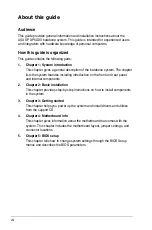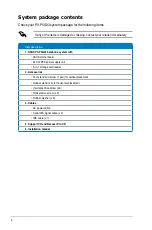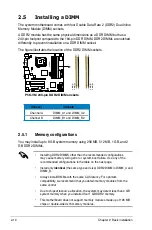
1-4
Chapter 1: System introduction
1. Cover screw.
Secures the system cover.
2. PS/2 keyboard port .
This purple 6-pin connector is for a PS/2 keyboard.
3. Parallel port .
This 25-pin port connects a printer, scanner, or other
devices.
4. Air vent.
Provides ventilation for the system.
5. 6-pin IEEE 1394a port
.
Provides high-speed connectivity for IEEE
1394a-compliant audio/video devices, storage peripherals, and other
consumer electronic devices.
6. LAN (RJ-45) port .
This port allows Fast Ethernet connection to a Local
Area Network (LAN) through a network hub.
7. Center/Subwoofer port (yellow orange).
This port connects the center/
subwoofer speakers.
8. Line In port (light blue).
This port connects a tape player or other audio
sources.
9. Line Out port (lime).
This port connects a headphone or a speaker. In 4/6/8-
channel configuration, the function of this port becomes Front Speaker Out.
10. Metal bracket lock.
Secures the expansion slot/card metal brackets.
11. Voltage selector.
Allows you to adjust the system input voltage according to
the voltage supply in your area. See the section
2.12 Selecting the voltage
before adjusting this switch.
12. Power connector.
Connects the power cable and plug.
13. USB 2.0 ports
.
These Universal Serial Bus 2.0 (USB 2.0) ports are
available for connecting USB 2.0 devices such as a mouse, printer, scanner,
camera, PDA, and others.
1.3
Rear panel
The system rear panel includes the power connector and several I/O ports that
allow convenient connection of devices.
1
2
3
4 5
6 7
8
9 10
11
12
1
21
20
19
18
17
16
15
14
13
Summary of Contents for P3-P5G33 - P Series - 0 MB RAM
Page 98: ...5 34 Chapter 5 BIOS setup ...















































